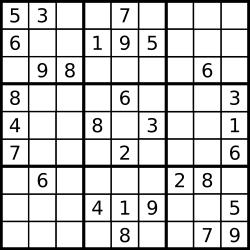问题描述:
Write a program to solve a Sudoku puzzle by filling the empty cells.
Empty cells are indicated by the character ‘.’.
You may assume that there will be only one unique solution.


分析:这道题使用的是回溯算法,回溯本质是深搜+剪枝。深搜又常常利用递归,然后当替换每个“.”时都判断是否有效。如果有效的话,就继续递归下去。
注意,一般递归函数都在开头位置判断是否结束,但是对于该问题而言,不大容易判断叶节点。所以这里采用的是利用返回值true或false来对树的深度进行控制。如果为solve到false时,就回溯。回溯的手段就是使用更改函数主体复位,并return。
代码如下:328ms
public class Solution {
public void solveSudoku(char[][] board) {
solve(board);
}
private boolean solve(char[][] board){
for(int row = 0;row<9;row++){
for(int col = 0;col<9;col++){
if(board[row][col] == '.'){
for(char i = '1';i<='9';i++){
board[row][col] = i;
if(isValid(board,row,col) && solve(board))
return true;
board[row][col] = '.';
}
return false;
}
}
}
return true;
}
private boolean isValid(char[][] board,int row,int col){
for(int i = 0;i<9;i++){
if(i!=col && board[row][i] == board[row][col])
return false;
}
for(int i = 0;i<9;i++){
if(i!=row && board[i][col] == board[row][col])
return false;
}
int beginRow = 3*(row/3);
int beginCol = 3*(col/3);
for(int i = beginRow;i<beginRow+3;i++){
for(int j = beginCol;j<beginCol+3;j++){
if(i!=row && j!=col && board[i][j] == board[row][col])
return false;
}
}
return true;
}
}




 本文介绍了一种使用回溯算法解决数独问题的方法,通过深搜和剪枝技术,实现对空格的有效填充,确保唯一解的存在。
本文介绍了一种使用回溯算法解决数独问题的方法,通过深搜和剪枝技术,实现对空格的有效填充,确保唯一解的存在。
















 604
604

 被折叠的 条评论
为什么被折叠?
被折叠的 条评论
为什么被折叠?








